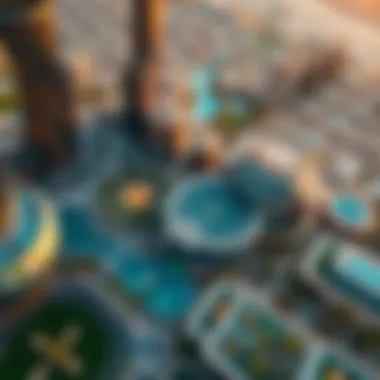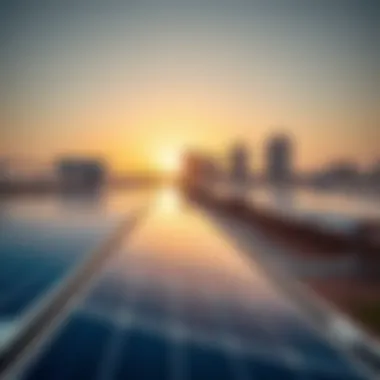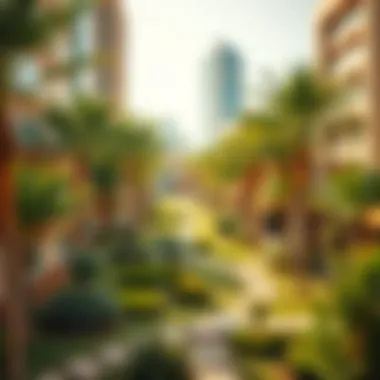Exploring Masdar City: A Model of Sustainable Urban Living


Intro
Masdar City stands as a beacon of innovation, representing a groundbreaking approach to urban development in the heart of the United Arab Emirates. As the world grapples with escalating environmental concerns and the need for sustainable living, this city emerges not just as a showcase but as a functional model for future cities. From solar energy to advanced transportation systems, Masdar City integrates state-of-the-art technology with a profound commitment to sustainability.
The focus here is on how Masdar City sets the stage for what urban development can and should look like moving forward. It’s not merely about eco-design; it is about reshaping our understanding of city life in a rapidly evolving global landscape. This exploration will dive into several facets, including market trends, investment opportunities, and the city’s strategic initiatives to promote a greener future. Each aspect tells part of a larger narrative about the potential of urban spaces to make meaningful changes in society and the environment.
In a world where climate change looms large, learning from Masdar City’s journey can provide invaluable insights. The city is not without its challenges, but it serves as a laboratory for solutions that may very well influence development policies worldwide in years to come.
Let’s embark on this comprehensive exploration, starting with an examination of the market trends that shape real estate in Masdar City.
Prolusion to Masdar City
Masdar City has become a focal point for discussions around sustainable urban living, representing a bold step towards a greener future in the United Arab Emirates. As we dive into the purpose and vision behind this unique enclave, it’s crucial to appreciate the innovative ideas that give rise to such an ambitious project. The importance of examining Masdar City lies not just in its commitment to sustainability but also in how it challenge conventional notions of urban design.
Every inch of this city seeks to harmonize modern technology with eco-friendly initiatives, making it an intriguing case study for real estate agents, investors, and urban planners alike. By focusing on sustainable practices, Masdar City demonstrates the potential of integrating environmental conservation into the daily lives of its residents.
The Origins of Masdar City
The journey of Masdar City began in the mid-2000s when Abu Dhabi embarked on a quest to explore and implement sustainable technologies. As oil-rich nations around the world grappled with the notion of sustainability, the UAE aimed to redefine its identity beyond fossil fuels. Conceived by the Abu Dhabi Future Energy Company, Masdar City was envisioned as a hub for research, development, and innovation in renewable energy. Its physical foundation was laid in 2008, and the initial design embraced traditional Arabic architecture while incorporating modern elements that reduced energy consumption.
The creators took inspiration from ancient neighborhoods, where narrow streets and courtyards provided shade and a community-oriented atmosphere. As such, the city was meticulously planned to minimize the use of cars and promote walking— this not only lowers emissions but encourages social interaction among residents.
Purpose and Vision
At its core, Masdar City aims to be a model for future urban development, emphasizing a sustainable lifestyle that balances economic, environmental, and social facets. The vision extends beyond merely housing or retail space; it seeks to create a self-sustaining ecosystem that demonstrates the viability of renewable energy sources. The ultimate aim is to achieve carbon neutrality.
The city is designed to generate its energy entirely from renewable sources like solar power and wind, pushing the envelope in energy efficiency. The vision also embraces education and research, making Masdar City home to institutions like the Masdar Institute of Science and Technology. Here, scholars and innovators converge to develop solutions to global energy challenges, further exemplifying the city’s commitment to sustainability.
"Masdar City’s design integrates cutting-edge technology with smart, sustainable living, aiming for a harmonious coexistence between nature and urban life."
Sustainable Urban Design
Sustainable urban design can be considered the backbone of modern city planning, particularly in a forward-thinking development like Masdar City. The intersection of ecological responsibility and urban functionality sets the stage for creating living spaces that minimize environmental impact while maximizing livability. Understanding the key aspects of sustainable urban design is critical for real estate agents, investors, and developers who seek to align their projects with long-term ecological and social goals.
Investing in sustainable urban design is no longer solely about being eco-friendly. It encompasses various elements that contribute to the overall well-being of residents, from energy efficiency to community integration. When city planners and architects weave sustainability into their designs, they not only reduce carbon footprints but also foster a sense of community, enhance public health, and ensure economic resilience. Even though maintaining this balance might seem challenging, the rewards it reaps underscore the importance of this approach in Masdar City.
Core Principles
At the heart of sustainable urban design lie several key principles that guide the development of Masdar City:
- Energy Efficiency: Building designs prioritize natural light and airflow, reducing energy needs and enhancing comfort.
- Water Conservation: Utilization of advanced irrigation techniques and greywater recycling systems contributes to effective water management.
- Mixed-Use Development: Integrating residential, commercial, and recreational spaces encourages walkability and reduces dependency on automobiles.
- Green Spaces: Parks and community gardens not only provide recreation but also improve air quality, offering social gathering places that promote well-being.
- Local Materials: Using locally sourced materials reduces transportation emissions and supports the local economy.
These principles are not just isolated theories; they form the bedrock of Masdar City's planning, helping to create a blueprint that other cities can explore and replicate.
Architectural Innovations
Architectural innovation in Masdar City is a testament to the interplay between design and technology. Here, architects have moved beyond traditional methods, incorporating cutting-edge solutions that exemplify sustainable living. Some notable innovations include:
- Zero-Energy Buildings: Many structures utilize photovoltaic panels to generate more energy than they consume, achieving the ambitious target of zero energy use.
- Smart Materials: Buildings are crafted using materials that respond to temperature fluctuations, thus minimizing the need for heating and cooling.
- Innovative Cooling Techniques: Architectural features like wind towers and shaded courtyards harness natural elements for passive cooling, reducing reliance on air conditioning.
As a result, these innovations did not simply focus on aesthetics, but rather emphasized efficiency and sustainability. They reflect a commitment to creating spaces that nurture human interaction while respecting the planet.
"The design is not just about appearance; it represents our values and aspirations for a sustainable future."
For more information about sustainable urban design, visit Wikipedia or Britannica.


Technological Advancements in Masdar City
In today’s fast-paced world, technology serves as the backbone of any modern city development. Masdar City stands at the forefront of sustainability, embodying technological advancements that reflect a commitment to eco-friendly living. By integrating state-of-the-art innovations, Masdar City seeks not only to minimize its environmental footprint but to also act as a blueprint for future urban developments worldwide. The importance of this topic in the discussion of Masdar City cannot be overstated, given that these technologies play a crucial role in achieving the ambitious goals set for the city.
Renewable Energy Sources
One of the most remarkable elements of Masdar City’s approach is its heavy reliance on renewable energy sources. The city utilizes a variety of technologies designed to harness energy from natural elements. Solar panels blanket rooftops, providing clean energy that powers not just individual homes but entire districts within the city. Additionally, wind turbines dot the landscape, generating even more renewable energy.
To give an example of this commitment, the Masdar Solar Plant stands out as a pivotal project, employing concentrated solar power technology that significantly boosts energy efficiency. This plant alone contributes to a substantial portion of the city’s power demand.
Moreover, the total reliance on renewable energy ensures that Masdar City maintains its carbon-neutral aspirations. It’s not just about reducing energy consumption; it’s about redefining how cities produce and consume energy.
Smart Transportation Systems
As part of its eco-conscious frameworks, Masdar City has turned its gaze towards smart transportation systems which are pivotal in reducing traffic congestion and ensuring seamless mobility. The Personal Rapid Transit (PRT) system is a cutting-edge example in this realm. This driverless, electric transportation service operates on-demand, much like a taxi but on a much smaller scale. It saves both time and energy.
In addition to PRT, a network of dedicated bike paths promotes cycling among residents. This leads to fewer vehicles on the road, culminating in a reduction of carbon emissions. The integration of these systems creates a more efficient, intelligent urban space that encourages residents to utilize sustainable transportation methods.
Waste Management Technologies
Waste management could easily get lost in the shuffle of advancements, yet in Masdar City, it’s a critical focus area owing to the environmental impact of waste disposal. Here, waste management technologies come into play, enhancing the city's sustainability credentials.
The city employs advanced recycling systems designed to sort and process waste effectively. Notably, Anaerobic Digesters convert organic waste into energy, which is then fed back into the power grid or utilized for heating. This process not only minimizes landfill use but also transforms waste into a resource—there’s your circular economy in action.
Further, educational programs aim to instill responsible waste disposal habits in residents, ensuring that the community actively participates in the process. Combining cutting-edge tech with community involvement is key in achieving a cleaner environment.
"Technological advancements in Masdar City exemplify a holistic approach to sustainability, aligning energy, transportation, and waste management with ecological goals."
In summary, the technological advancements in Masdar City are diverse and mutually reinforcing, working together to create a cohesive framework aimed at sustainable living. As the city evolves, these innovations are not just local solutions but serve as insights for urban planners and developers around the globe. The lessons learned here could very well shape the future of cities everywhere, from Abu Dhabi to Berlin.
Economic Landscape of Masdar City
The economic landscape of Masdar City embodies a unique confluence of sustainability and innovation, offering insightful benefits and considerations for various stakeholders. Situated within the United Arab Emirates, this city is not merely a hub for eco-friendliness; it serves as a burgeoning platform for business and investment. The economic framework here is designed to support a green economy, making it a significant case study for investors, developers, and policymakers. The blend of ambitious sustainability goals and a robust economic strategy showcases how environmental agendas can, indeed, harness economic growth.
Investment Opportunities
The investment opportunities in Masdar City are as varied as they are promising. Since its inception, the city has actively attracted foreign direct investment by positioning itself as a pioneer in the renewable energy sector. Investors looking to tap into this market will find a climate conducive to growth, supported by government incentives aimed at promoting green initiatives. With projects such as the Masdar Institute of Science and Technology and the International Renewable Energy Agency (IRENA) headquarters, the city serves as an incubator for cutting-edge technology and innovative research.
- Renewable Energy Projects: Investments in solar energy, wind energy, and other renewables are at the forefront.
- Real Estate Development: Opportunities abound for commercial and residential infrastructure that aligns with sustainable living principles.
- Technology Startups: The Masdar City Free Zone encourages entrepreneurs launching tech firms centered on environmental solutions.
Investors must consider that while the potential is ripe, the path is not without challenges. For one, staying aligned with Masdar City’s strict sustainability criteria requires diligence and adaptability on the part of investors.
Business Ecosystem
Masdar City’s business ecosystem is designed to create symbiotic relationships among companies, innovators, and the government. The unique characteristics of this ecosystem not only support existing businesses but also invite new players to join the fold. A thriving network of companies focusing on renewable energy, sustainability consulting, and eco-technologies are gathering under the city’s umbrella.
In this ecosystem:
- Collaboration is Key: Businesses often find synergy in partnerships that emphasize joint solutions to environmental challenges.
- Access to Resources: Companies benefit from proximity to research institutions and access to cutting-edge scientific knowledge.
- Government Support: Initiatives and funding from the UAE government encourage technology transfer and development.
"Masdar City exemplifies how a well-structured economic environment can foster sustainability while attracting global investment."
The city is continually evolving, as are the opportunities it presents. As the world faces increasing pressure to address climate change, Masdar City stands ready, showcasing how economic viability can be intricately linked with environmental responsibility. This presents an enormous opportunity for investors and businesses, making Masdar City a model for future urban developments globally.
Environmental Impact
The significance of environmental impact is paramount in the discussion of Masdar City, a pioneering initiative in sustainable urban development. As climate change looms large, cities are at the forefront of the challenges, and Masdar City acts as a notable reference point for how urban environments can evolve in harmony with nature. This section explores how Masdar City is tailored not only for human needs but also designed with the environment front and center.


Carbon Neutrality Goals
Achieving carbon neutrality is not merely a goal but a necessity for the long-term viability of our planet. Masdar City aims to be one of the first carbon-neutral cities globally. This ambitious commitment reflects a deep understanding of carbon footprints and their impacts. The city employs various measures to ensure that it actually delivers on this promise.
- Energy Efficiency Strategies: Masdar City utilizes cutting-edge technologies. Buildings are constructed to high efficiency standards, reducing energy consumption without losing comfort or convenience. From energy-efficient materials to state-of-the-art heating and cooling systems, the design focuses on minimizing energy use.
- Renewable Energy Utilization: Solar power plays a crucial role in achieving carbon neutrality. Masdar City is home to the largest solar installation in the region, generating energy that powers the community, demonstrating how renewable energy can be integrated into urban infrastructure.
- Green Transport: Reducing reliance on fossil fuels is also essential to maintain a low carbon footprint. The city promotes sustainable transportation methods, like electric vehicles and efficient public transport, cutting down greenhouse gas emissions.
"Masdar City is more than just a place; it’s a living experiment in sustainable living."
Biodiversity and Nature
Integrating nature into urban life is vital for maintaining biodiversity, and Masdar City exemplifies this integration well. The planning incorporates various elements that support both local wildlife and residents. Keeping a balance so that nature and city life coexist is what makes Masdar unique.
- Protected Green Spaces: The city boasts numerous parks and green zones, which not only beautify the environment but provide essential habitats for local flora and fauna. These areas foster biodiversity and contribute to the mitigation of urban heat effects.
- Ecosystem Restoration Projects: Projects are in place that aim to restore and rehabilitate natural habitats in and around Masdar City. Involving local communities in these initiatives encourages a sense of stewardship towards the environment.
- Sustainable Landscaping: Landscaping in Masdar is done with an ecological approach, using native plants that require minimal irrigation. This not only conserves water but also provides suitable habitats for wildlife, promoting a rich biodiversity even within the urban setting.
Social Aspects of Living in Masdar City
The social dynamics of living in Masdar City play a pivotal role in the overall success of this ambitious project. It's not just about innovative buildings or cutting-edge technology; it's the everyday human experience that ultimately defines this unique urban environment. People here experience a blend of community spirit and modern living that sets Masdar City apart from conventional urban areas. This section will explore key aspects like community engagement and cultural integration, which contribute significantly to the social fabric of the city.
Community Engagement
At the heart of Masdar City’s social structure lies a strong emphasis on community engagement. This is no accident; it’s a deliberate strategy aimed at fostering a sense of belonging among residents. Community involvement is crucial in shaping not only the immediate living environment but also in developing relationships that flourish in shared spaces.
One notable example is the regular community events organized by Masdar, which include everything from clean-up drives to cultural festivals. These events are designed not only to bring people together but also to cultivate a sense of responsibility towards the environment. Residents participate in these activities, helping to maintain the greenery and sustainability that Masdar stands for. The city encourages collaboration through initiatives that enable residents to contribute ideas for further community improvement, directly impacting decision-making processes.
Moreover, the design of the urban layout promotes interaction. Narrow streets intended for pedestrians connect shared spaces, allowing residents to encounter each other naturally, thereby creating opportunities for social exchange. In turn, this enhances the social relations within Masdar City leading to stronger networks among neighbors.
"A city is more than its buildings, it's about the people who live there and their stories."
Cultural Integration
Cultural integration is another cornerstone of living in Masdar City. The area showcases an eclectic mix of cultural backgrounds, primarily reflecting the diversity of the United Arab Emirates itself. Here, expats can find a slice of home while local Emiratis enrich the community with their traditions, thus setting the stage for a cultural crossroads.
The city has actively promoted cultural initiatives to bring together its residents. For instance, communal art projects and music events often highlight various cultural expressions that allow people from different backgrounds to collaborate and share their unique traditions. This not only enriches the community's collective identity but also helps to break down barriers that might otherwise exist in a multicultural society.
Education also plays a pivotal role in this aspect. Schools in Masdar emphasize cultural awareness and inclusivity, preparing children to grow into globally minded citizens. As a result, younger generations learn to appreciate diversity from an early age. This creates a ripple effect, encouraging acceptance and respect among all community members.
Challenges Faced by Masdar City
When embarking on an ambitious project like Masdar City, it is crucial to spotlight the challenges that arise. These obstacles can often provide insights into the dynamics of sustainable urban development. Identifying and understanding these hurdles will be more than just an academic exercise; it unlocks the broader implications for cities striving for similar aspirations. By scrutinizing the issues surrounding Masdar City, we can glean lessons applicable to urban planning across the globe.
Economic Viability
One of the foremost hurdles Masdar City faces is ensuring economic viability. Creating a completely sustainable urban environment is not merely a test of innovative thoughts but also a balancing act of financial feasibility. Masdar's unique selling proposition lies in its sustainable architecture and smart technology. However, these elements tend to come with heightened costs.
The initial expenditure is daunting. Significant investments in cutting-edge renewable technologies can lead to higher prices for consumers. That can rattle potential investors. Consequently, Masdar's management must engage in transparent discussions about the cost-benefit equation of sustainable urban living.
- Ensuring continuous funding from both local and international investors is vital for sustaining growth.
- Developing partnerships with established firms and academic institutions can help ease the financial burden and foster innovation.
Achieving a balance between sustainability and market competitiveness will prove critical for Masdar's ongoing success.
Public Perception
Public perception of Masdar City plays a nuanced role in its development. While Masdar aims for a high standard of sustainable living, how the community views these efforts fundamentally affects engagement and growth. If residents and prospective residents do not feel connected to the city’s sustainable ethos, building a cohesive community will be complex.
A significant concern can be the misinterpretation of Masdar's high-tech image. The perception that it serves as an exclusive space for wealthy individuals can deter diversity and inclusivity. Numerous campaigns have been launched to better connect with the public, yet challenges persist.


- One approach could be the integration of community forums, offering platforms for feedback and discussions on city governance.
- Educational initiatives about sustainability to aid in reframing the narrative and engaging with the broader audience.
Building trust and support from residents can ultimately determine how effectively Masdar can adapt to future challenges.
Technological Limitations
Masdar City is a showcase of advanced sustainable technologies, yet these innovations come with inherent limitations. The very nature of pioneering technology implies the presence of risks and shortcomings. For instance, while solar panels are a core part of Masdar's infrastructure, their efficiency may be impacted by the region's dust accumulation or maintenance issues in the extreme climate.
Embracing a tech-heavy approach also brings complexities in execution. The city demonstrates several interconnected systems—from energy generation to waste management—requiring careful coordination. Any glitches in one can reverberate across the entire framework.
- Tech, while beneficial, needs continuous upgrades and adjustments to align with evolving global standards and scientific discoveries.
- Emphasizing resilient technology and backup systems can ensure the sustainability of essential services and infrastructure.
In sum, navigating through these technological obstacles while embracing innovation is paramount for Masdar City.
In grappling with economic viability, public perception, and technological limitations, Masdar City serves as a complex laboratory for potential models of sustainable urban environments worldwide.
By addressing these challenges head-on, Masdar can evolve into a blueprint for future urban development, blending practical solutions with innovative practices.
Future Prospects of Masdar City
The future of Masdar City is more than just an outlook; it embodies the evolution of urban living in a world grappling with environmental challenges. Its significance lies in demonstrating how innovative design and technology can work hand-in-hand to create sustainable environments. As cities worldwide contend with issues like climate change, population density, and resource scarcity, Masdar City serves as a vital example in the implementation of forward-thinking solutions.
The next chapters of Masdar City are set to unfold, highlighting upcoming developments that aim to solidify its status as a leader in sustainable practices.
Upcoming Projects and Developments
Several ambitious projects are lined up, each designed to push Masdar City closer to its lofty goals. For instance, the expansion of the Masdar Institute of Science and Technology will involve cutting-edge research in renewable energy and sustainable development, nurturing a new generation of innovators. Further, the construction of more residential areas is slated to provide eco-friendly housing options fitted with smart technologies.
Some key upcoming initiatives include:
- Zero-Carbon Buildings: The introduction of new commercial and residential structures designed to produce more energy than they consume.
- Enhanced Transportation Systems: Integrating autonomous vehicles alongside existing efficient public transport to reduce reliance on fossil fuels.
- Green Roof Initiatives: Expanding vegetative roofs that contribute to energy efficiency and enhancing the urban ecosystem.
These projects underscore a thoughtful progression towards creating a holistic living experience, setting benchmarks for other developments in the region.
Global Influence and Lessons Learned
Masdar City is not just an isolated project but a beacon for global urban planning. Its endeavors have provided valuable lessons that may shape future urban projects around the world. Key insights include:
- Collaboration Across Sectors: The synergy between government bodies, private enterprise, and educational institutions has been vital. Cooperation hastens the innovation process and amplifies public impact.
- Long-Term Vision Over Short-Term Gains: The focus on sustainability demands a commitment to long-term planning. Quick fixes won't suffice; instead, investing in sustainable infrastructure becomes essential.
- Community Involvement: Engaging local residents in the planning process fosters community pride and ownership over the project, ensuring its success and longevity.
Masdar City's journey serves as both a laboratory and showcase for sustainable urban living, with most lessons learned resonating in cities striving for greener futures. In echoing these considerations, it's imperative that other global cities take note, adapting them to their unique contexts while maintaining a clear focus on sustainability.
"Cities must be a place where the environment thrives, not merely a habitat for human beings. Masdar City is paving a pathway toward that future."
In summary, the future prospects of Masdar City are intricately woven with broader global challenges and solutions. As it embraces new projects and exports its lessons learned, it paves the way for an urban renaissance that can inspire and guide other cities to reimagine their own futures with sustainability at the forefront.
The End
Masdar City serves as a beacon in the realm of sustainable urban planning, demonstrating the potential of innovative approaches to tackle some of today’s gravest environmental challenges. As we sift through the intricate layers of this master-planned city, the emphasis on sustainability becomes evident, but its implications reach far beyond mere environmental concerns. Not only does Masdar City adhere to principles of renewable energy and efficient resource management, it also offers a blueprint for future urban developments worldwide.
Summary of Key Findings
Throughout our exploration, several notable points arise that underscore Masdar City's significance:
- Sustainability Integrated into Urban Design: The city’s architecture and layout prioritize green spaces, natural cooling systems, and energy efficiency, all of which exemplify a forward-thinking approach to urban living.
- Technological Integration: From smart transportation systems to state-of-the-art energy production, Masdar stands at the forefront of technological advancement in urban contexts.
- Economic Opportunities: By offering a conducive environment for innovation and investment, Masdar City is not just a model of sustainability but also a thriving economic hub, attracting various businesses and startups.
- Community Engagement: The strong focus on community involvement illustrates a commitment to fostering a sense of belonging among residents, a crucial component in creating sustainable urban spaces.
These findings clearly indicate that Masdar City is not merely an isolated example but a critical piece in the larger puzzle of how cities can evolve in environmentally and socially responsible ways.
Looking Ahead
Looking towards the future, several aspects merit attention:
- Expansion of Sustainable Practices: As climate concerns intensify, cities all over the globe may adopt practices and policies showcased by Masdar. The city serves as a touchstone, bridging the gap between innovation and application.
- Global Collaborations: There’s potential for Masdar to spearhead initiatives in collaboration with various nations to develop global standards for sustainable urbanism.
- Continuous Adaptation: The city will need to remain flexible, embracing new technologies and methods to stay relevant. Its willingness to adapt will be critical in ensuring long-term sustainability.











